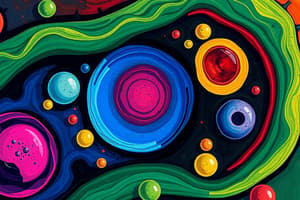Podcast
Questions and Answers
What separates the internal contents of a plant cell from its surrounding environment?
What separates the internal contents of a plant cell from its surrounding environment?
Plasma membrane
What is the main component that the cytoplasm of a cell consists of?
What is the main component that the cytoplasm of a cell consists of?
Water
What is housed in the nucleus of a cell?
What is housed in the nucleus of a cell?
- Cytoplasm
- Proteins
- Ribosomes
- DNA (correct)
Chromatin is visible during all phases of the cell cycle.
Chromatin is visible during all phases of the cell cycle.
What is the role of ribosomes in a cell?
What is the role of ribosomes in a cell?
What do mitochondria produce for the cell?
What do mitochondria produce for the cell?
What is the function of peroxisomes in a cell?
What is the function of peroxisomes in a cell?
Animal cells contain chloroplasts.
Animal cells contain chloroplasts.
What structure is responsible for the plant cell's rigid shape?
What structure is responsible for the plant cell's rigid shape?
Which organelle is primarily responsible for packaging and distributing lipids and proteins?
Which organelle is primarily responsible for packaging and distributing lipids and proteins?
The cytoskeleton consists of protein fibers such as ________, intermediate filaments, and microtubules.
The cytoskeleton consists of protein fibers such as ________, intermediate filaments, and microtubules.
What is the main function of lysosomes in animal cells?
What is the main function of lysosomes in animal cells?
What pigment in chloroplasts captures light energy for photosynthesis?
What pigment in chloroplasts captures light energy for photosynthesis?
Which organelle modifies and synthesizes lipids?
Which organelle modifies and synthesizes lipids?
Centrioles are found in plant cells.
Centrioles are found in plant cells.
Flashcards are hidden until you start studying
Study Notes
Cell Structure and Function
- Plant cells possess a rigid cell wall composed of cellulose, providing structure and support.
- Animal cells lack a cell wall; instead, they have a flexible plasma membrane that regulates the entry and exit of substances.
- Both cell types contain cytoplasm, a gel-like substance comprising organelles and 70-80% water.
Nucleus
- The nucleus is the most prominent organelle, housing DNA and directing ribosome and protein synthesis.
- Contains nucleoplasm, where the nucleolus synthesizes ribosomal RNA from certain DNA segments.
- The nuclear envelope is a double membrane with pores for substance exchange between the nucleus and cytoplasm.
Ribosomes
- Ribosomes are protein synthesis sites, appearing as small dots either free-floating or attached to the endoplasmic reticulum (ER).
- They consist of two subunits and translate messenger RNA (mRNA) into proteins.
Mitochondria
- Known as the powerhouse of the cell, mitochondria produce ATP through cellular respiration, converting glucose and oxygen into energy.
- They have a double membrane with inner folds called cristae and contain their own ribosomes and DNA.
Peroxisomes and Glyoxysomes
- Peroxisomes are responsible for the oxidation of fatty acids and amino acids, detoxifying poisons by converting them into safe byproducts.
- Glyoxysomes, a specialized type, convert stored fats into sugars in plant cells.
Vesicles and Vacuoles
- Vesicles and vacuoles are membrane-bound sacs used for storage and support. Vacuoles are larger and involved in breaking down macromolecules.
- Plant cells contain a large central vacuole that regulates water concentration and provides structural support.
Centrosome and Lysosomes
- Centrosomes, found in animal cells, contain a pair of centrioles, aiding in cell division by organizing microtubules.
- Lysosomes act as the cell’s "garbage disposal," containing enzymes for breaking down worn-out organelles and other cellular debris.
Chloroplasts
- Present in plant cells, chloroplasts conduct photosynthesis, containing chlorophyll to capture light energy. They have a double membrane and their own DNA.
Endoplasmic Reticulum (ER)
- The endoplasmic reticulum is a network of membranous sacs, comprising rough ER (with ribosomes for protein modification) and smooth ER (involved in lipid synthesis and detoxification).
Golgi Apparatus
- The Golgi apparatus modifies, packages, and distributes proteins and lipids received from the ER.
- It has a cis face that receives vesicles and a trans face where modified products are sent to their destinations.
Cytoskeleton
- The cytoskeleton provides structural support and aids in cellular movement, composed of microfilaments, intermediate filaments, and microtubules.
- Microfilaments support movement and shape; intermediate filaments maintain structure; microtubules facilitate vesicle transport and chromosome separation during cell division.
Comparison of Plant and Animal Cells
- Plant cells have a cell wall, chloroplasts for photosynthesis, and a large central vacuole, while animal cells contain lysosomes and centrioles.
- Both cells contain microtubule organizing centers (MTOCs), but their structures and functions differ significantly, reflecting their roles in organisms.
Performance Task
- Create a 3D model of plant and animal cells using recyclable materials to understand their structures and components better.
Studying That Suits You
Use AI to generate personalized quizzes and flashcards to suit your learning preferences.




